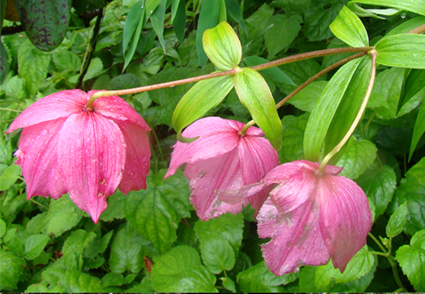Abstract
Lilium punctulatum, a taxon endemic to northwestern Yunnan, used to be considered a form of Lilium pardanthinum. It is here investigated and proposed for species rank. Morphologically, it is closest to L. basilissum and L. sealyi, but it can be differentiated by its dark red spots on pinkish petals, inner tepals margin shallowly erose or lacerate, elliptic to lanceolate-elliptic leaves and a saucer-shape perigone. This species has a narrow distribution and small population size, which makes it vulnerable to extinction, and thus it needs urgent conservation attention.
References
Evans, W.E. (1925) A revision on the genus Nomocharis. Notes from the Royal Botanic Garden, Edinburgh 15: 27–30.
Franchet, A.R. (1889) Nomocharis. Journal de Botanzque 3: 113–114.
Gao, Y.D., Harris, A.J. & He, X.J. (2015) Morphological and ecological divergence of Lilium and Nomocharis within the Hengduan Mountains and Qinghai-Tibetan Plateau may result from habitat specialization and hybridization. BMC Evolutionary Biology 15: 147. https://dx.doi.org/10.1186/s12862-015-0405-2
Gao, Y.D., Hohenegger, M., Harris, A.J., Zhou, S.D., He, X.J. & Wan, J. (2012) A new species in the genus Nomocharis Franchet (Liliaceae): evidence that brings the genus Nomocharis into Lilium. Plant Systmatics and Evolution 298: 6–85. https://dx.doi.org/10.1007/s00606-011-0524-1
Gao, Y.D. & Gao, X.F.(2016) Accommodating Nomocharis in Lilium (Liliaceae). Phytotaxa 277: 205–210. https://dx.doi.org/10.11646/phytotaxa.277.2.8.
Gao, Y.D. & Gao, X.F. (2020) Lilium sealyi Y.D.Gao, a new name for Lilium farreri (W.E.Evans) Y.D.Gao. Phytotaxa 449: 299–300. https://dx.doi.org/10.11646/phytotaxa.449.3.9.
IUCN (2022) Guidelines for using the IUCN red list categories and criteria. Version 15. Prepared by the Standards and Petitions Committee. Downloadable from https://www.iucnredlist.org/documents/RedListGuidelines.pdf. (Accessed 21 March 2022).
Liang, S.Y. (1984) Studies on the genus Nomocharis (Liliaceae). Bulletin of Botanical Research 4: 163–178.
Liang, S.Y. & Tamura, M.N. (2000) Lilium L.; Nomocahris Franchet. In: Wu, Z.Y. & Raven, P.H. (eds.) Flora of China, vol 24. Science Press, Beijing and Missouri Botanical Garden Press, St. Louis, pp 135–150.
Linnaeus, C. (1753) Species plantarum. Salvius, Stockholm, 302 pp.
Léveillé, H. (1913) Decades plantarum novarum. Repertorium specierum novarum regni vegetabilis 12: 281–288. https://dx.doi.org/10.1002/fedr.19130121707
Liu, J.Q., Wang, Y.J., Wang, A.L., Hideaki, O. & Abbott, R.J. (2006) Radiation and diversification within the Ligularia-Cremanthodium-Parasenecio complex (Asteraceae) triggered by uplift of the Qinghai-Tibetan Plateau. Molecular Phylogenetics and Evolution 38: 31–49. https://dx.doi.org/10.1016/j.ympev.2005.09.010.
Sealy, J.R. (1950) Nomocharis and Lilium. Kew Bulletin 5: 273–297. https://dx.doi.org/10.2307/4117245
Sealy, J.R. (1978) Nomocharis pardanthina. Notes from the Royal Botanic Garden 36: 293–296.
Sealy, J.R. (1983) A revision of the genus Nomocharis Franchet. Botanical Journal of the Linnean Society 87: 285–323. https://dx.doi.org/10.1111/j.1095-8339.1983.tb00996.x
Sun, Y.S., Wang, A.L., Wan, D.S., Wang, Q. & Liu, J.Q. (2012) Rapid radiation of Rheum (Polygonaceae) and parallel evolution of morphological traits. Molecular Phylogenetics and Evolution 63: 150–158. https://doi.org/10.1016/j.ympev.2012.01.002.
Zhang, J.Q., Meng, S.Y., Allen, G.A., Wen, J. & Rao, G.Y. (2014) Rapid radiation and dispersal out of the Qinghai-Tibetan Plateau of an alpine plant lineage Rhodiola (Crassulaceae). Molecular Phylogenetics and Evolution 77: 147–158. https://doi.org/10.1016/j.ympev.2014.04.013


